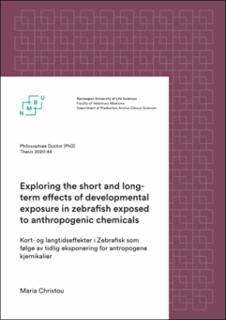| dc.description.abstract | Persistent organic pollutants (POPs) are anthropogenic chemicals omnipresent in the environment and animal tissues. Due to their persistency they are rarely found as single compounds within organisms but rather in complex mixtures. Epidemiological and animal studies have associated exposure to POPs with adverse effects spanning the lifetime of an organism. However, as these chemicals might interact in a synergistic or antagonistic manner, predicting their effects from single chemical toxicology studies is challenging. Additionally, due to the lipophilic nature of many of these chemicals, solvents are used in animal studies to accommodate their administration to test tissues although the solvents themselves may also affect endpoints of interest. The aims of the current thesis were to evaluate whether methodological approaches such as the use of solvents and other laboratory practices can affect the outcome of toxicology studies using a behavioral paradigm in zebrafish. Additionally, using zebrafish as an animal model we set to investigate the short- and long-term effects of chemical exposure to a complex mixture of POPs on physiological and behavioral endpoints.
Neurotoxicity effects of chemicals are often evaluated using behavioral tests, and zebrafish larvae have been used regularly in recent years because of their small size that facilitates large screening of multiple chemicals simultaneously. However, many different experimental and methodological parameters can affect the locomotor behavior of larval zebrafish. Using a light-dark transition test we investigated whether different concentrations of common solvents such as dimethyl sulfoxide (DMSO) and methanol can affect basal locomotor behavior. Furthermore, we investigated the effects of other parameters such as the use of the antifungal agent (methylene blue, MB), media volume in wells and different laboratory strains. Finally, we tested the interaction between DMSO or MB with positive controls on behavioral endpoints. DMSO and MB increased basal locomotor activity in a dose dependent manner as did media volume. Furthermore, even if basal locomotor activity was different among zebrafish stains, all strains responded in the same manner to the solvents and MB, therefore the choice of strains should not be of concern when designing behavioral tests using zebrafish. However, results indicated that DMSO and MB could both have additive or interactive effects on behavioral endpoints when combined with positive controls (Paper I).
Taking into consideration the parameters affecting zebrafish larval behavior, we investigated the short and long-term effects of exposure to a complex mixture of POPs or perfluorooctanesulfonic acid (PFOS) on zebrafish larvae and adults. The POP mixture consists of 29 chemicals and was based on the average blood levels in the Scandinavian population. PFOS was identified as a driving agent of behavioral changes in previous studies and was included as a single exposure to test whether responses to the mixture are comparable to PFOS responses. Embryos were exposed to two concentrations of the POP mixture or PFOS alone (10x and 70x what is found on average human blood levels) from 6 – 96 hours post fertilization (hpf) and afterwards reared in clean water until adulthood. In larvae we tested the effects of exposure on behavior, using the light-dark transition and thigmotaxis test and we employed transcriptomics analysis in order to identify possible mechanisms of action. In adults we measured growth, swimming performance, and reproductive output at different life stages. In addition, we assessed anxiety behavior of the adults and their offspring, as well as performing a transcriptomic analysis on the adult zebrafish brain.
Behavioral responses of 96 hpf larvae included hyperactivity and higher thigmotaxis in the exposed individuals. Transcriptome analysis revealed upregulation of transcripts related to muscle contraction and further pathway analysis revealed that one of the most affected pathways was the calcium signaling pathway via the activation of ryanodine receptors (RyR). Mechanistic analyses with RyR inhibitors and behavioral outcomes substantiate these findings. In adults, exposure to the POP mixture and PFOS reduced swimming performance and increased length and weight, compared to controls. No effect of developmental exposure was observed on reproductive output, adult anxiety behavior, or behavior of subsequent offspring. Pathway analysis of the brain transcriptome of adults exposed as larvae to the low concentration of PFOS revealed enrichment in pathways such as calcium, mitogen-activated protein kinase (MAPK), and gamma-Aminobutyric acid (GABA) signaling, all of which are important for learning and memory (Paper II & III)
To conclude, the results obtained in this dissertation increase our understanding of how different methodological approaches can affect the locomotor activity of larval zebrafish and point to the necessity of protocol standardization to increase the reproducibility and comparability of results among laboratories. Zebrafish proved a useful and practical model to assess the toxicity of complex POP mixtures. Most of the effects were comparable between single and mixture exposures, but some differences were also evident, such as exposure effects on gene expression. | en_US |

